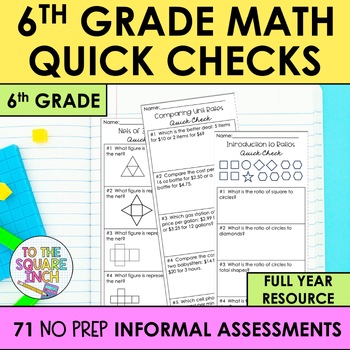6th Grade Math Exit Slips - Informal Math Assessments for 6th Grade
To the Square Inch- Kate Bing Coners
16.3k Followers
Resource Type
Standards
CCSS6.G.A.1
CCSS6.G.A.2
CCSS6.G.A.3
CCSS6.G.A.4
CCSS6.SP.A.1
Formats Included
- PDF
Pages
140 pages
To the Square Inch- Kate Bing Coners
16.3k Followers
What educators are saying
I have used this with my intervention students and loved it! What a great way to do some quick checks!
Using these as quick assessments to determine where my incoming 7th graders are in need of remediation.
Also included in
- 6th Grade Math Ultimate Bundle Unlock a world of math excellence with this comprehensive 6th Grade Math Ultimate Curriculum Bundle. This all-in-one resource is the key to ensuring your students not only grasp mathematical concepts but thrive in their 6th-grade math journey.Unbelievable Savings: ThisPrice $600.00Original Price $1333.00Save $733.00
- Grades 5-8 Grade Math Quick Check Worksheets by Topic BundleThis set of printable worksheets is a perfect way to quickly assess your students on all 5th-8th grade math topics. Each page focuses on one topic and gives students 5 quick problems to complete. Pages are formatted with 2 of the same setsPrice $24.00Original Price $48.00Save $24.00
Description
6th Grade Math Quick Check Worksheets by Topic
This set of 71 printable worksheets is a perfect way to quickly assess your students on all 6th grade math topics. Each page focuses on one topic and gives students 5 quick problems to complete. Pages are formatted with 2 of the same sets of questions per page. These worksheets make great exit slips, homework or bellringers.
This aligns with the To the Square Inch 6th Grade Math Curriculum and follows the Common Core Standards. It is easy to mix and match sets to meet your individual standards.
Topics covered in this product:
- Multiplying Fractions
- Dividing Fractions
- Dividing Mixed Numbers
- Dividing Multi-Digit Numbers
- Adding and Subtracting Decimals
- Multiplying Decimals
- Dividing Decimals by Whole Numbers
- Dividing Decimals by Decimals
- Greatest Common Factor
- Least Common Multiple
- Introduction to Integers
- Negative Fractions and Decimals
- Opposite Values
- Reflecting Coordinates
- Absolute Value
- Comparing and Ordering Integers
- Coordinate Plane
- Order of Operations
- Algebraic Expressions Vocabulary
- Writing Algebraic Expressions
- Reading Algebraic Expressions
- Evaluating Algebraic Expressions
- Equivalent Expressions
- Combining Like Terms
- The Distributive Property
- Writing Equations
- Checking Solutions
- Solving Equations with Addition and Subtraction
- Solving Equations with Multiplication and Division
- Writing Inequalities
- Graphing Inequalities
- Solving Inequalities with Addition and Subtraction
- Solving Inequalities with Multiplication and Division
- Equations in 2 Variables
- Area of Rectangles and Parallelograms
- Area of Triangles
- Area of Trapezoids
- Area of Composite Figures
- Volume of Rectangular Prisms
- Volume of Rectangular Prisms with Fractional Edges
- Distance in the Coordinate Plane (quadrant 1)
- Polygons in the Coordinate Plane
- Nets of 3-D Figures
- Surface Area of Rectangular Prisms
- Surface Area of Triangular Prisms
- Surface Area of Pyramids
- Introduction to Ratios
- Unit Rate
- Equivalent Ratios
- Ratios with Tape Diagrams
- Comparing Unit Rates
- Introduction to Percents
- Percents and Fractions
- Percents and Decimals
- Percent of a Number
- Finding the Whole
- Converting Measurements
- Statistical Questions
- Shapes of Distributions
- Finding Mean
- Finding Mode
- Finding Median
- Finding Range
- Quartiles
- Interquartile Range (IQR)
- Mean Absolute Deviation (MAD)
- Line Plots
- Histograms
- Box and Whisker Plots
- Stem and Leaf Plot
Answer keys are included for each worksheet.
Be sure to check out the preview to see all pages
Total Pages
140 pages
Answer Key
Included
Teaching Duration
1 Year
Report this resource to TPT
Reported resources will be reviewed by our team. Report this resource to let us know if this resource violates TPT’s content guidelines.
Standards
to see state-specific standards (only available in the US).
CCSS6.G.A.1
Find the area of right triangles, other triangles, special quadrilaterals, and polygons by composing into rectangles or decomposing into triangles and other shapes; apply these techniques in the context of solving real-world and mathematical problems.
CCSS6.G.A.2
Find the volume of a right rectangular prism with fractional edge lengths by packing it with unit cubes of the appropriate unit fraction edge lengths, and show that the volume is the same as would be found by multiplying the edge lengths of the prism. Apply the formulas 𝘝 = 𝘭 𝘸 𝘩 and 𝘝 = 𝘣 𝘩 to find volumes of right rectangular prisms with fractional edge lengths in the context of solving real-world and mathematical problems.
CCSS6.G.A.3
Draw polygons in the coordinate plane given coordinates for the vertices; use coordinates to find the length of a side joining points with the same first coordinate or the same second coordinate. Apply these techniques in the context of solving real-world and mathematical problems.
CCSS6.G.A.4
Represent three-dimensional figures using nets made up of rectangles and triangles, and use the nets to find the surface area of these figures. Apply these techniques in the context of solving real-world and mathematical problems.
CCSS6.SP.A.1
Recognize a statistical question as one that anticipates variability in the data related to the question and accounts for it in the answers. For example, “How old am I?” is not a statistical question, but “How old are the students in my school?” is a statistical question because one anticipates variability in students’ ages.







